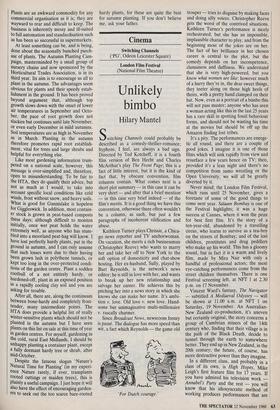Gardens
Potted philosophy
Ursula Buchan
11 over the country gardeners are grafting tomatoes, growing terrestrial orchids and discussing the merits of water- retaining polyacrylamides. Every time I give a talk to amateur gardeners, I am impressed by how much they know. When do they have the time to learn it all? The number of enthusiastic gardeners is large — even discounting all those who profess to being keen because gardening has be- come smart. Yet, in some important, re- spects, we are not the gardeners we were. We are not necessarily inferior to our forefathers, but we are different. In par- ticular, we have abandoned some time- honoured practices.' For . . For example, as a result of the wholesale introduction of containerisation — horrid word — of plants by growers, most garden- ers no longer view the autumn as the principal time for planting. In the past, gardening depended to a greater degree on faith: plants bought to put in the ground in the late autumn were leafless stems with bare roots, dug out of nursery fields, and you had little idea of what they would look like until the following spring. Today we practise 'instant gardening', which neatly matches the mood of the age. In theory at least you can now go to the local garden centre on the spur of the moment, buy plants in full flower and leaf, and make a garden at a stroke.
Container plants have particularly appealed to the new gardener, which is fair enough. One should never underestimate the timidity of people cast adrift in a strange sea of Latin names and chemical formulae; the beginner is quite naturally ignorant of climatic conditions, soil consti- tuents, even how to weed and plant. Plants in containers, which the garden centres say can be taken out of the pot and put straight into the ground at any time of the year, have seemed the answer. "
However, the policy of 'containerising' almost everything, from alpines to stan- dard trees, has had one unwanted result for garden centres. Because of the Iron Law of Unintended Consequences, sales have be- come concentrated in spring and early summer, when most plants look their best. Losses after planting are a problem, as dry spells kill the ill-established and, usually, unwatered plants. Losses mean com- plaints, and complaints about perishable plants are notoriously hard to disprove. Plants are an awkward commodity for any commercial organisation as it is; they are wayward to rear and difficult to keep. The business is inherently messy and ill-suited to full automation and standardisation such as has been so successful in supermarkets.
At least something can be, and is being, done about the seasonally bunched purch- ase of plants. The Autumn Planting Cam- paign, masterminded by a small group of nursery chains and now sponsored by the Horticultural Trades Association, is in its third year. Its aim is to encourage us all to plant in the autumn. The advantages seem Obvious for plants and their speedy estab- lishment in the ground. It has been proved beyond argument that, although top growth slows down with the onset of lower air temperatures in September and Octo- ber, the pace of root growth does not slacken but continues until late November, or even early December in mild autumns. Soil temperatures are as high in November as in March. Planting in the autumn therefore promotes rapid root establish- ment, vital for trees and large shrubs and helpful for everything else.
Like most gardening information trum- peted on a national scale, however, this message is over-simplified and, therefore, Open to misunderstanding. To be fair to the HTA, they do qualify their advice, but not as much as I would, to take into account specific local conditions like cold winds, frost without snow, and heavy soils. What is good for Gunnislake is hopeless for Giggleswick. In addition, most contain- er stock is grown in peat-based composts these days; although difficult to moisten initially, once wet peat holds the water extremely well, as anyone who has stum- bled into a moorland peat-hag will know. I have lost perfectly hardy plants, put in the ground in autumn, and I can only assume that such losses were due to their having been grown lush in polythene tunnels, or kept too long in the over-protected condi- tions of the garden centre. Plant a sodden rootball of a not entirely hardy, or hardened-off, plant in an exposed position in a rapidly cooling clay soil and you are asking for trouble.
After all, there are, along the continuum between bone-hardy and completely frost- tender, many intermediate points. The FITA does provide a helpful list of really winter-sensitive plants which should not be planted in the autumn but I have seen Plants on this list on sale at this time of year in garden centres. For myself, gardening in the cold, rural East Midlands, I should be unhappy planting a container plant, except a fully dormant hardy tree or shrub, after mid-October.
Despite the fatuous slogan Nature's Natural Time for Planting' (in my experi- ence Nature rarely, if ever, transplants rooted cuttings or maiden trees), this is Plainly a useful campaign. I just hope it will also have the effect of encouraging garden- ers to seek out the too scarce bare-rooted hardy plants, for these are quite the best for autumn planting. If you don't believe me, ask your father.











































































 Previous page
Previous page